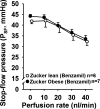Role of connecting tubule glomerular feedback in obesity related renal damage
- PMID: 30303713
- PMCID: PMC6336995
- DOI: 10.1152/ajprenal.00227.2018
Role of connecting tubule glomerular feedback in obesity related renal damage
Abstract
Zucker obese rats (ZOR) have higher glomerular capillary pressure (PGC) that can cause renal damage. PGC is controlled by afferent (Af-Art) and efferent arteriole (Ef-Art) resistance. Af-Art resistance is regulated by factors that regulate other arterioles, such as myogenic response. In addition, it is also regulated by 2 intrinsic feedback mechanisms: 1) tubuloglomerular feedback (TGF) that causes Af-Art constriction in response to increased NaCl in the macula densa and 2) connecting tubule glomerular feedback (CTGF) that causes Af-Art dilatation in response to an increase in NaCl transport in the connecting tubule via the epithelial sodium channel. Since CTGF is an Af-Art dilatory mechanism, we hypothesized that increased CTGF contributes to TGF attenuation, which in turn increases PGC in ZOR. We performed a renal micropuncture experiment and measured stop-flow pressure (PSF), which is an indirect measurement of PGC in ZOR. Maximal TGF response at 40 nl/min was attenuated in ZOR (4.47 ± 0.60 mmHg) in comparison to the Zucker lean rats (ZLR; 8.54 ± 0.73 mmHg, P < 0.05), and CTGF was elevated in ZOR (5.34 ± 0.87 mmHg) compared with ZLR (1.12 ± 1.28 mmHg, P < 0.05). CTGF inhibition with epithelial sodium channel blocker normalized the maximum PSF change in ZOR indicating that CTGF plays a significant role in TGF attenuation (ZOR, 10.67 ± 1.07 mmHg vs. ZLR, 9.5 ± 1.53 mmHg). We conclude that enhanced CTGF contributes to TGF attenuation in ZOR and potentially contribute to progressive renal damage.
Keywords: CTGF; TGF; obesity; renal damage.
Conflict of interest statement
No conflicts of interest, financial or otherwise, are declared by the authors.
Figures







Similar articles
-
A Novel Mechanism of Renal Microcirculation Regulation: Connecting Tubule-Glomerular Feedback.Curr Hypertens Rep. 2019 Jan 18;21(1):8. doi: 10.1007/s11906-019-0911-5. Curr Hypertens Rep. 2019. PMID: 30659366 Free PMC article. Review.
-
Connecting tubule glomerular feedback mediates tubuloglomerular feedback resetting after unilateral nephrectomy.Am J Physiol Renal Physiol. 2018 Oct 1;315(4):F806-F811. doi: 10.1152/ajprenal.00619.2016. Epub 2017 Apr 19. Am J Physiol Renal Physiol. 2018. PMID: 28424211 Free PMC article.
-
Tubuloglomerular and connecting tubuloglomerular feedback during inhibition of various Na transporters in the nephron.Am J Physiol Renal Physiol. 2015 May 1;308(9):F1026-31. doi: 10.1152/ajprenal.00605.2014. Epub 2015 Feb 25. Am J Physiol Renal Physiol. 2015. PMID: 25715987 Free PMC article.
-
Effect of salt intake on afferent arteriolar dilatation: role of connecting tubule glomerular feedback (CTGF).Am J Physiol Renal Physiol. 2017 Dec 1;313(6):F1209-F1215. doi: 10.1152/ajprenal.00320.2017. Epub 2017 Aug 23. Am J Physiol Renal Physiol. 2017. PMID: 28835421 Free PMC article.
-
Cross-talk between arterioles and tubules in the kidney.Pediatr Nephrol. 2009 Jan;24(1):31-5. doi: 10.1007/s00467-008-0852-8. Epub 2008 May 17. Pediatr Nephrol. 2009. PMID: 18488254 Free PMC article. Review.
Cited by
-
Obesity-related glomerulopathy: Current approaches and future perspectives.Obes Rev. 2022 Jul;23(7):e13450. doi: 10.1111/obr.13450. Epub 2022 Apr 1. Obes Rev. 2022. PMID: 35362662 Free PMC article. Review.
-
Role of Alström syndrome 1 in the regulation of glomerular hemodynamics.Am J Physiol Renal Physiol. 2023 Oct 1;325(4):F418-F425. doi: 10.1152/ajprenal.00017.2023. Epub 2023 Aug 10. Am J Physiol Renal Physiol. 2023. PMID: 37560774 Free PMC article.
-
Exploring Renal Changes after Bariatric Surgery in Patients with Severe Obesity.J Clin Med. 2022 Jan 29;11(3):728. doi: 10.3390/jcm11030728. J Clin Med. 2022. PMID: 35160179 Free PMC article.
-
A Novel Mechanism of Renal Microcirculation Regulation: Connecting Tubule-Glomerular Feedback.Curr Hypertens Rep. 2019 Jan 18;21(1):8. doi: 10.1007/s11906-019-0911-5. Curr Hypertens Rep. 2019. PMID: 30659366 Free PMC article. Review.
-
Decreased tubuloglomerular feedback response in high-fat diet-induced obesity.Am J Physiol Renal Physiol. 2022 Apr 1;322(4):F429-F436. doi: 10.1152/ajprenal.00307.2021. Epub 2022 Feb 28. Am J Physiol Renal Physiol. 2022. PMID: 35224993 Free PMC article.
References
-
- Baylis C, Ichikawa I, Willis WT, Wilson CB, Brenner BM. Dynamics of glomerular ultrafiltration. IX. Effects of plasma protein concentration. Am J Physiol Renal Physiol 232: F58–F71, 1977. - PubMed
-
- Bondar’ IA, Klimontov VV, Simakova AI. [Obesity and chronic kidney disease]. Ter Arkh 83: 66–70, 2011. - PubMed
Publication types
MeSH terms
Substances
Grants and funding
LinkOut - more resources
Full Text Sources
Medical
Miscellaneous

